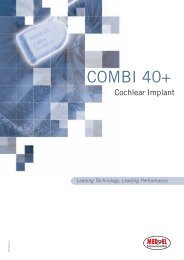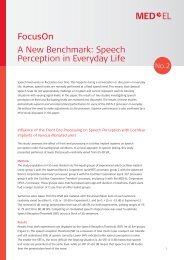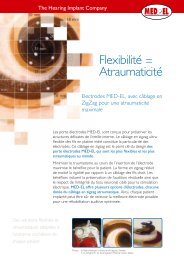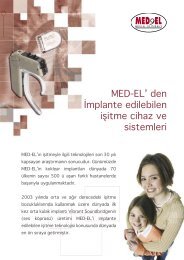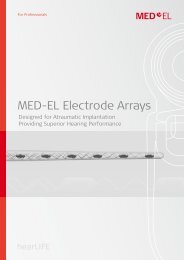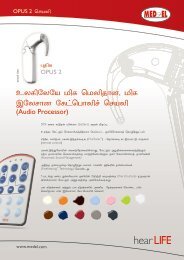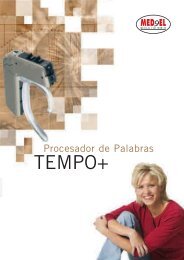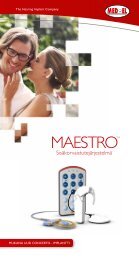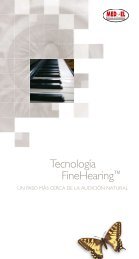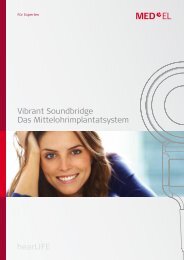MED-EL Cochlear Implant Systems Provide Best Benefit FocusOn
MED-EL Cochlear Implant Systems Provide Best Benefit FocusOn
MED-EL Cochlear Implant Systems Provide Best Benefit FocusOn
You also want an ePaper? Increase the reach of your titles
YUMPU automatically turns print PDFs into web optimized ePapers that Google loves.
Mean scores<br />
80<br />
70<br />
60<br />
50<br />
40<br />
30<br />
20<br />
10<br />
Conclusion<br />
<strong>MED</strong>‑<strong>EL</strong> cochlear implants quickly provide significant gains in a variety of aspects of hearing for<br />
users of all ages. Moreover, <strong>MED</strong>‑<strong>EL</strong> cochlear implants define the benchmark of performance for<br />
the whole industry.<br />
References<br />
0<br />
7.0<br />
14.3<br />
Interval 1<br />
Mean improvement after training over time: Total scores stratified per group<br />
37.0<br />
20.3<br />
32.7<br />
71.0<br />
26.0<br />
48.4<br />
Interval 2 Interval 3 Interval 4 Interval 5 Interval 6<br />
Error bars represent positive standard deviations<br />
Anderson et al. (2007) The EARS test battery: Providing normative data. Poster at 11th<br />
International Conference on CI in Children, 11–14 April, Charlotte, U.S.A.<br />
Anderson et al. (2000) Opinions on cochlear implant use in senior <strong>MED</strong>‑<strong>EL</strong> Patients. ORL, 68:<br />
283‑289.<br />
Anderson et al. (2006) Telephone use: what benefit do cochlear implant users receive? Int J<br />
Audiol, 45: 446‑453.<br />
Au et al. (2003) Superiority of bilateral cochlear implantation over unilateral cochlear<br />
implantation in tone discrimination in Chinese patients. Am J Otolaryngol, 24:19‑23.<br />
Baumgartner et al. (2007) Outcomes in adults implanted with the Flexsoft electrode. Acta Oto‑<br />
Laryngologica, 127: 579‑86.<br />
Buss et al. (2008) Multicenter U.S. Bilateral <strong>MED</strong>‑<strong>EL</strong> <strong>Cochlear</strong> <strong>Implant</strong>ation Study: Speech<br />
Perception over the First Year of Use. Ear Hear, 29(1): 20‑32.<br />
Castro et al. (2006) Comparison of different mobile telephones in COMBI 40+ users. Acta<br />
Otolaryngol, 126:714‑7.<br />
Coninx et al. (2009) Validation of the LittlEARS® Auditory Questionnaire in children with normal<br />
hearing. IJPORL, 73(12): 1761‑68.<br />
Haumann et al. (2009) <strong>Benefit</strong>s of Electrical Stimulation Over Two <strong>Cochlear</strong> Turns in<br />
Postlingually Deafened CI Users – A Prospective Long‑Term Study. Poster at Conference on<br />
<strong>Implant</strong>able Auditory Prosthesis, July 12–17, Lake Tahoe, USA.<br />
Haumann et al. (2010) Speech perception with cochlear implants as measured using a roving‑<br />
level adaptive test method, ORL, 72: 312‑18.<br />
Hinderink et al. (2000) Development and application of a health‑related quality‑of‑life<br />
instrument for adults with cochlear implants: The Nijmegen <strong>Cochlear</strong> <strong>Implant</strong> Questionnaire.<br />
Otolaryngol Head Neck Surg, 123: 756‑65.<br />
Koşaner et al. (2009) Music for young CI users. Presented at 9th European Symposium on<br />
Paediatric CI, 14–17 May, Warsaw, Poland.<br />
30.3<br />
47.1<br />
38.4<br />
57.0<br />
Total score group A Total score group B Total score group C<br />
43.4<br />
61.5<br />
Figure 13: Overall music<br />
listening scores for very<br />
young (19–37 months at<br />
study start), young (34–60<br />
months at study start)<br />
and older children (49–88<br />
months at study start)<br />
over time, as measured on<br />
a music rating scale.<br />
Adapted from Koşaner et<br />
al., 2009<br />
11



